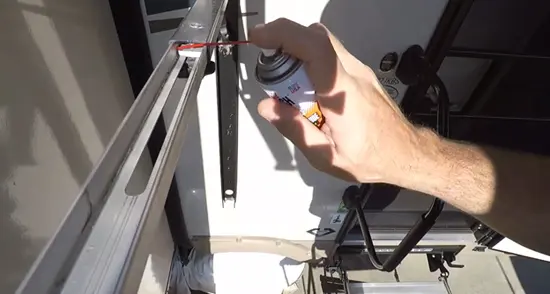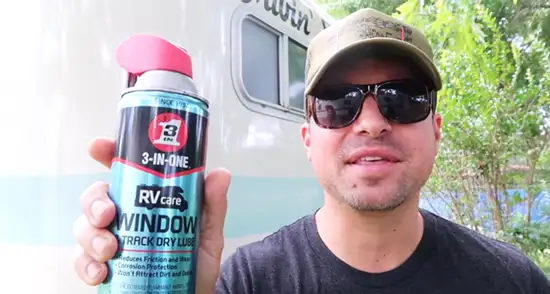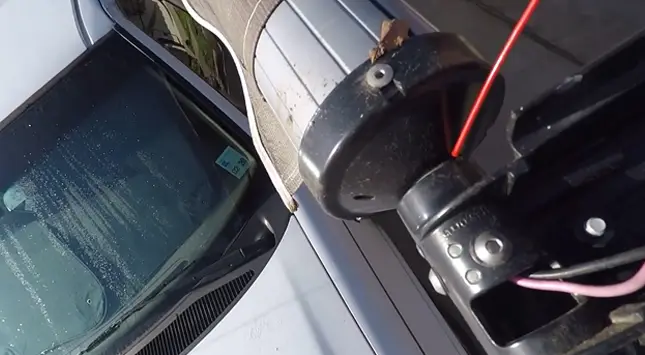Last Updated on September 25, 2023
One of the most important but often neglected parts of regular care is lubricating the awning. Without routine inspection and maintenance, a canopy can quickly deteriorate to operate.
They need to be well greased in order to make the RV slide smoothly when opening and closing. To maintain an RV awning is to lubricate it regularly. There are two types of lubricants that may be used: silicone and Teflon.
Silicone is the preferred material because it does not attract dust and dirt as Teflon does. We will walk you through the steps of how to lube RV awning. Keep reading for more information.
How to Lube RV Awning in 4 Steps?

RV awning maintenance is important to keep them functioning properly and in good condition. Lubing is a simple process that only takes a few minutes.
You will need to gather a few supplies before you get started, including lubricant and wax. Once you have everything you need, simply follow these steps:
Step 01: Clean the Fabric of the Awning
Begin by washing the fabrics with a mild soap and water solution. Rinse thoroughly afterward to remove any soap residue. You may need to use a mild bleach solution if it is very dirty and stained.
Avoid using harsh chemicals or scrubbing too vigorously, as this may deteriorate the fabric. Regular cleaning will remove dirt, grime, and stains and will prevent the growth of mold and mildew.
Step 02: Apply a Coat of Wax to the Fabric
The application of wax polishing is an easy way to protect it from dirt and stains. Wax creates a barrier between the fabric and the outside, and it can repel liquids.
Fabrics that have been treated with wax are less likely to become stained or discolored. Once you have the wax, apply it to a small area of the fabric with a sponge or brush. Work in small circles, and be sure to coat the entire area.
After evenly distributing, allow it to dry for the recommended amount of time before buffing it to a shine. When applied correctly, wax can be an effective way to protect any type of fabric.
Step 03: Apply Lubricant to the Roller Tube and Arms
Lubricating your awning will ensure that it operates smoothly and effortlessly for years to come. The best time to apply lubricant is in the spring before you open the awning for the season. Start by opening the awning all the way and wiping down the roller tube and arms with a clean, dry cloth.
Once they are clean and dry, apply a silicone-based lubricant to the roller tube, using your hands to work it into the crevices. Next, apply lubricant to the arms, moving them back and forth to evenly distribute the lubricant.
Step 04: Lubricate the Awning Rail with a Silicone Spray
Silicone spray would be a helpful tool in this process. By creating a protective layer between fabric and metal, silicone spray prevents staining and fading as it repels water, which also stops rusting.
Regularly silicone sprays on the rail will lubricate the parts and prevent corrosion, making it easier for you to close and open.
To use silicone spray, clean the rail with a soapy solution to remove any dirt. Next, spray onto the rail using a back-and-forth motion. Make sure to cover the entire surface of the rail.
Finally, wipe away any excess silicone spray with a fresh piece of wiping fabric. Then you can prevent the build-up of grime and allow it easier for the awning to slide smoothly along the rail.
What Are the Factors to Consider When Cooking in an Awning?
When cooking in an awning, several factors should be taken into account to ensure a successful and enjoyable experience. Adequate ventilation is one of the cooking in an awning essentials, as it helps eliminate smoke and odors. Additionally, choosing lightweight and compact cooking equipment is crucial for easy transport and storage. Lastly, considering the weather conditions and the awning’s stability is vital to prevent accidents and maintain a safe cooking environment.
Why Do You Need to Lube Awnings on RVs?

Lubricating the moving parts of your RV awnings is an important part of regular maintenance. Metal moving against metal creates friction, which can wear down the components over time.
Friction produces heat, which can damage or even melt the materials. By fluidizing the awning components, you can reduce wear and tear, prolong the life of the awning, and prevent costly repairs.
The best time to fluidize your awning is when you first notice that it’s not moving as smoothly as it should. Once a month, before you extend or retract the awning, apply a few drops of lubricant to the moving parts.
Be sure to remove excess lubricant, as it can attract dirt and debris. With regular lubrication, your RV awning will provide years of trouble-free operation.
FAQs
1. What’s the best way to lubricate a Retractable Awning?
It is important to lubricate them on a periodic basis. The frequency will depend on how frequently you use it, but generally, a good idea should be to lube it at a minimum of yearly.
Use any type of oil fluid that is designed for moving parts, such as WD-40 or grease. Simply apply the lubricant to all of the moving components, including the crank mechanism and the fabric itself.
Once you have applied the lubricant, operate the awning a few times to spread it evenly.
2. Is it OK to lubricate an electric RV awning?
It’s perfectly fine to lubricate an electric RV awning. In fact, it’s a good idea to do so on a regular basis. The main thing to keep in mind is to use a lubricant that is specifically designed for use on electric awnings.
The best way to do this is to use a silicone-based lubricant. Silicone lubricants are designed specifically for use on electrical components, and they will not damage the awning fabric or cause any adverse effects.
Once the lubricant has been applied, it is important to open and close the awning several times to distribute the product evenly. With proper care and maintenance, an electric RV awning will provide trouble-free operation.
3. What Type of Lubricant Should You Use on RV Awnings?
Any kind of liquid sealant can be used for RV maintenance, but the best option is silicone lubricant. This type of fluid will help to protect from UV radiation and also prevent the fabric from sticking together.
Silicone-like Boeshield t 9 oils are very easy to apply and typically do not require any special equipment. If you are unsure which form of lubing fluid to use, always consult your owner’s manual for guidance.
4. How Often Should You Lube RV Awnings?
We recommend that you lubricate and check for repair on a regular yearly basis, ensuring to keep the awning fabric away from drying out and cracking. The best could be lubing every month.
One important thing to remember is that you should never store an awning while it is wet. This could cause the fabric to mildew or rot. Instead, you should try to dry it completely before rolling it up for storage.
Conclusion
While there are many ways to go about lubricating your RVs, we recommend getting a silicone-based spray. Now that you know how to lube RV awning, it’s important to perform this task at least once a year.
This will keep it in good condition and protect the fabric, keeping it functioning properly and prolonging its life. Make sure to store any excess lubricant, so you have it on hand the next time you decide to lube.
So those are all of the things that you need to do in order to properly lubricate the awning of your RV. It is important that you take the time to do it correctly.



